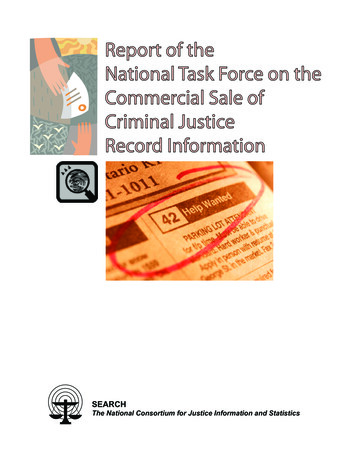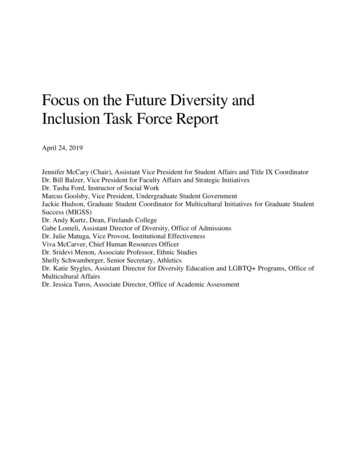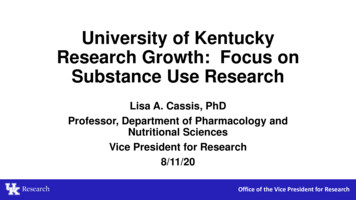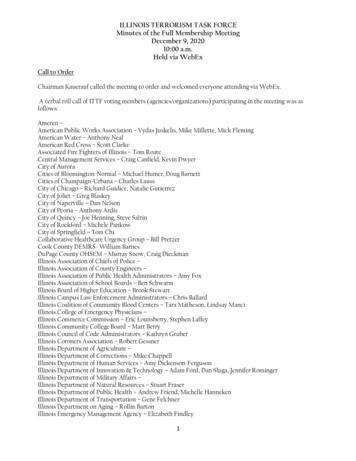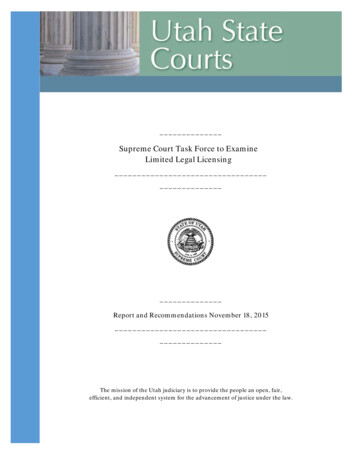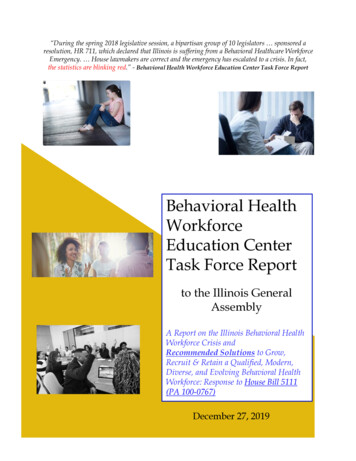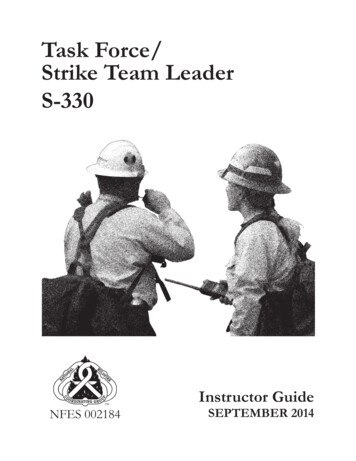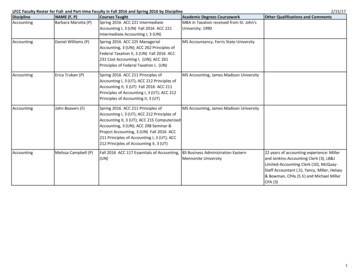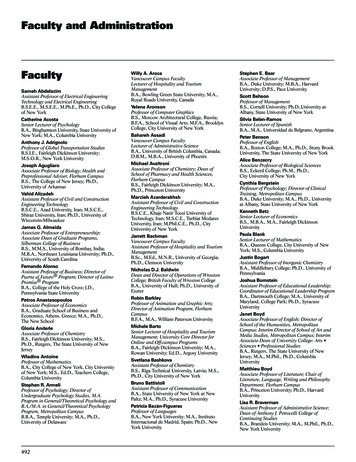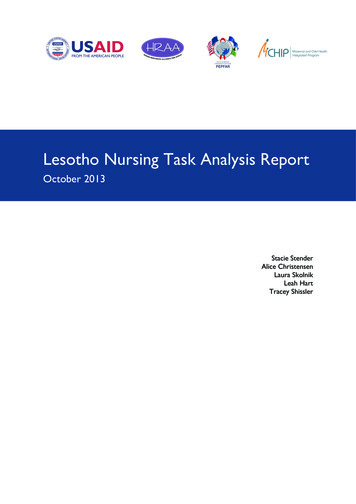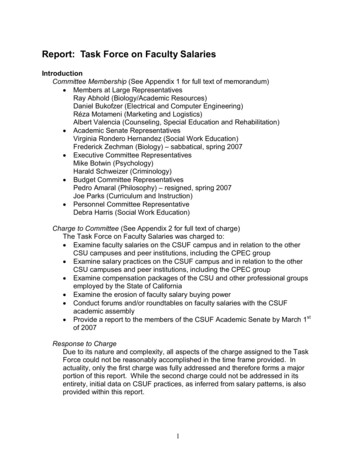
Transcription
Report: Task Force on Faculty SalariesIntroductionCommittee Membership (See Appendix 1 for full text of memorandum)· Members at Large RepresentativesRay Abhold (Biology/Academic Resources)Daniel Bukofzer (Electrical and Computer Engineering)Réza Motameni (Marketing and Logistics)Albert Valencia (Counseling, Special Education and Rehabilitation)· Academic Senate RepresentativesVirginia Rondero Hernandez (Social Work Education)Frederick Zechman (Biology) – sabbatical, spring 2007· Executive Committee RepresentativesMike Botwin (Psychology)Harald Schweizer (Criminology)· Budget Committee RepresentativesPedro Amaral (Philosophy) – resigned, spring 2007Joe Parks (Curriculum and Instruction)· Personnel Committee RepresentativeDebra Harris (Social Work Education)Charge to Committee (See Appendix 2 for full text of charge)The Task Force on Faculty Salaries was charged to:· Examine faculty salaries on the CSUF campus and in relation to the otherCSU campuses and peer institutions, including the CPEC group· Examine salary practices on the CSUF campus and in relation to the otherCSU campuses and peer institutions, including the CPEC group· Examine compensation packages of the CSU and other professional groupsemployed by the State of California· Examine the erosion of faculty salary buying power· Conduct forums and/or roundtables on faculty salaries with the CSUFacademic assembly· Provide a report to the members of the CSUF Academic Senate by March 1stof 2007Response to ChargeDue to its nature and complexity, all aspects of the charge assigned to the TaskForce could not be reasonably accomplished in the time frame provided. Inactuality, only the first charge was fully addressed and therefore forms a majorportion of this report. While the second charge could not be addressed in itsentirety, initial data on CSUF practices, as inferred from salary patterns, is alsoprovided within this report.1
The DataExternal SourceThe principal source of data for this report comes from the American Associationof University Professors (AAUP) Faculty Salary Survey. Data from the surveyprovides average faculty salaries arranged by academic rank (full professor,associate professor, and assistant professor) at more than 1,300 colleges anduniversities.The colleges and universities within the AAUP data are divided by CarnegieClassification into doctoral degree granting, masters degree granting,baccalaureate degree granting, and associate degree granting institutions.Salaries are reported in thousands of dollars and are rounded to the nearesthundred. To accommodate institutional variation (9 vs. 12 month faculty,academic year vs. year round faculty), salaries were adjusted to representearnings for an academic work year. The numbers cover full time members ofeach institution's instructional staff, except those in medical and dental schools.There are certain advantages and disadvantages in using a single source ofexternal data.Advantages:· The institutions themselves have provided their data following thesame self reporting guidelines.· The data are compiled for a single reason. Thus, all comparisons willbe consistent, assuming errors are constrained within the data set.· Emphasis can be placed on data analysis rather than the source of thedata, the validity of the data, or the accuracy of the data (i.e. having toaddress the means by which data was collected, the reason it wascollected, and what was included or excluded from the data).Disadvantages· It is assumed the data, even self reported, are accurate. To infer thatexternal validation or replication is unnecessary may be unwarranted.· It is assumed the data are being used for its intended purpose.· It is assumed the data are sufficient to answer the questions beingposed.· While comparisons between individual institutions are not influencedby the absence of weighted averaging, the grouping of institutions, asis done in parts of this study, would benefit from weighted averaging,which was not possible, given the data at hand. Without suchaveraging, salary practices at one institution are given equal weightwith all others regardless of faculty numbers. The impact of suchanalysis is debatable.Internal SourcesInstitutional Research, Assessment and Planning (IRAP)Faculty salary data for academic year (AY) 2000 01 through AY 2005 06,maintained in a data warehouse by IRAP, was made available to the2
committee. These data were used to confirm CSUF data obtained fromexternal sources (see below).Academic Personnel (AP)Faculty salary data for AY 2005 06 was provided by Academic Personnel.These data were used to provide a more detailed breakdown of facultysalaries on the CSUF campus. This, in turn, was thought to provide asnapshot of recent salary decision making practices.Data Collection and ManipulationExternal data (AAUP)All available data for AY 2000 01 through AY 2005 06 were downloaded from thewebsite (http://chronicle.com/stats/aaup/) as text files. The text files weremanipulated to comma delimited text and then converted to Excel files. Furtherdata manipulation within Excel generated the data points expressed in the figurespresented below. The Excel files can be made available upon request.Internal data (Institutional Research and Academic Personnel)All data was provided as Excel files. Further data manipulation within Excelgenerated the data points expressed in the figures presented below. The Excelfiles can be made available upon request.Ph.D. Granting InstitutionsAll Ph.D. granting institutions within the AAUP data were collated by academicyear. For the years used in this analysis, the number of Ph.D. grantinginstitutions in the study ranged from a minimum of 203, in AY 2000 01, to amaximum of 221, in AY 2005 06.Masters Granting InstitutionsAll Master’s granting institutions within the AAUP data were collated by academicyear. For the years used in this analysis, the number of Masters grantinginstitutions in the study ranged from a minimum of 396, in AY 2000 01, to amaximum of 420 institutions, in AY 2005 06.CPEC InstitutionsThe list of CPEC institutions has not changed since 1997. The list was obtainedfrom CPEC and is provided (See Appendix 3). The CPEC institution data withinthe AAUP data were extracted and treated as a separate data set. The data inthis study were found to be different than that used by CPEC in its analysis offaculty salaries. The reasons for this are twofold: (1) the data provided directly toCPEC by participating institutions is edited to exclude salaries of selected fieldsof study: (2) the data used by CPEC is weighted by the number of faculty withineach rank at each participating institution. Faculty numbers are not provided inthe AAUP data.3
CSU SystemTwenty two CSU campuses are represented within the AAUP data for AY 2000 01 and AY 2001 02. A twenty third campus (CSU Channel Islands) was addedto the AAUP data set in AY 2003 04. The CSU data was provided to AAUP bythe Chancellor’s Office. The data for CSU campuses were extracted and treatedas a separate data set.CSUFThe data for CSUF within the AAUP data were extracted and treated as aseparate data set. This provided the means by which CSUF data could becompared to ‘the rest’ of the CSU. CSUF data provided by IRAP and AP atCSUF were each treated as separate data sets. It is noted that a single datapoint, identified as an anomaly, was removed from the data set provided by AP.Findings for AY 2000 01 through AY 2005 06General CommentsIn order to demonstrate comparisons in the data examined, a series of figureshave been developed (See Appendix 4). All but three CPEC institutions aredoctoral granting, by Carnegie classification. The universities within the CSU areself identified as Master’s granting institutions. These differences are the reasonthat some have questioned the appropriateness of drawing conclusions fromcomparisons of the CSU and the CPEC group. This argument aside, it is notsurprising faculty salaries for CPEC institutions closely mirror faculty salaries fordoctoral granting institutions.Verification of CSUF Data As Provided by AAUPAs indicated, one of the disadvantages of using any data, particularly that from asingle data source, is the question of accuracy or verifiability. In this particularinstance, CSUF data obtained from the AAUP could be compared with on campus data. With the assistance of IRAP, on campus CSUF data for AY 2000 01 through AY 2005 06 was collated and compared against the data providedAAUP by the CSU Chancellor’s Office (CO). The figures representing thesecomparisons by academic rank are provided in Figures 1, 2, and 3. It can beseen from these figures that the CSUF data obtained by AAUP from the CO wasessentially identical to the data provided by IRAP.External Comparisons CSUF Salaries and Other InstitutionsFull ProfessorFigure 4: The average CSUF full professor salary is on par with the averageof salaries of their counterparts in the CSU system.Figure 5: CSU and CSUF full professors earn significantly less than fullprofessors at Ph.D. granting institutions and those at institutions within theCPEC group. On the other hand, CSU and CSUF full professors earnsignificantly more than those at MA granting institutions. Full professors atPh.D. granting, CPEC, and MA granting institutions experienced a steady4
climb in salaries over the 6 year period examined in this study. With theexception of AY 2003 04 and AY 2004 05, matching increases in salarieswere seen in CSU institutions and CSUF. The salary stasis for the twoidentified academic years effectively increased the gap between CSU/CSUFsalaries and Ph.D. granting/CPEC institutions – further driving CSU/CSUFsalaries toward the salaries of full professors at MA granting institutions.Associate ProfessorFigure 6: For AY 2000 01 through AY 2002 03, the salaries of CSUFassociate professors were much like their counterparts in the rest of the CSU.In the subsequent three academic years, AY 2004 05 through AY 2005 06,associate professor salaries at CSUF fell behind the CSU average and belowsalaries paid in AY 2002 03.Figure 7: As was seen for full professors, the salaries at Ph.D. granting,CPEC, and MA granting institutions grew steadily over the 6 years examinedin this study. For AY 2000 01 through AY 2002 03, similar increases werealso seen in CSU and CSUF salaries. The salaries of associate professorswithin the CSU and at CSUF were closely aligned with Ph.D. and CPECsalaries in AY 2000 01 through AY 2001 02, becoming nearly equivalent inAY 2002 03. In subsequent years, however, as the salaries at Ph.D. grantingand CPEC institutions continued to rise, the salaries in the CSU were eitherstagnant or showed modest gains while those at CSUF experienced a modestregression. Again, the salary stasis since AY 2002 03 effectively increasedthe gap between CSU/CSUF salaries and Ph.D. granting/CPEC institutions,further driving CSU/CSUF salaries toward those of associate professors atMA granting institutions.Assistant ProfessorFigure 8: For all academic years examined, assistant professors at CSUFwere near the bottom of those paid to their counterparts within the rest of theCSU. Moreover, the salary gap has increased since AY 2001 02.Figure 9: CSU and CSUF assistant professors earn significantly less thanthose at Ph.D. granting and CPEC institutions. On the other hand, CSU andCSUF assistant professors earn slightly more than those at MA grantinginstitutions. As was seen for full and associate professors, the salaries atPh.D. granting, CPEC, and MA granting institutions experienced a steadyclimb over the 6 year period examined in this study. With the exception ofAY 2003 04 and AY 2004 05, matching increases in salaries were seen inCSU and CSUF institutions. The salary stasis for the two identified academicyears effectively increased the gap between CSU/CSUF salaries and Ph.D.granting/CPEC institutions, further driving CSU/CSUF salaries toward thesalaries of assistant professors at MA granting institutions.5
Internal Comparisons – CSUF SalariesCSUF Salaries by Rank (Figure 10)On average, and as expected, assistant professors are paid less thanassociate professors and, in turn, associate professors are paid less than fullprofessors. As viewed by minimums and maximums, it is also apparent thatsome assistant professors are paid more than some associate professors andfull professors and some associate professors are paid more than some fullprofessors.CSUF Salaries by College/School (Figures 11 through 14)There are notable differences in the overall average salaries paid by theschools and colleges (Figure 11). Two colleges, Craig School of Business(CSB) and Engineering (ENR), are specifically noted for being higher than therest. On the other end of the spectrum, the averages of faculty salaries inthree colleges fall below the university average and below those of all otherschools and colleges. These include Arts and Humanities (AH), Science andMathematics (CSM) and Social Sciences (SS).On the high end, the observed differences are essentially sustained whensalaries are broken down by rank (Figures 12, 13 and 14). That is, theaverage CSB and ENR salaries at all ranks are still substantially higher thansalaries at equivalent ranks in the other schools and colleges. On the lowend, the differences are also sustained to a degree. The average of assistantand associate professor salaries within AH, CSM, and SS are below theuniversity average and below those of the other schools and colleges. Incontrast, and with the exception of CSB and ENR, the average full professorsalary in the remaining schools and colleges are below the university averageand not substantially different from one another.The variance in average college/school salaries is also reduced by rank. Thatis, the spread between average assistant professor’s salaries ( 30.8K – AHvs. CSB) is greater than that of associate professor’s salaries ( 25K – CSMvs. CSB) which, in turn, is greater than the spread of full professor salaries( 10.6K – SS vs. CSB).CSUF Salaries by Department (Figures 15 through 18)The generalized differences and trends observed when comparing salaries bycollege and school (Figures 11 through 14) are also reflected in the datawhen they are further subdivided by departments (Figures 15 through 18 –see Appendix 5 for chart legend to department names). It is noted, however,that specific inter departmental differences within some schools or collegesrender the generalized statements made previously somewhat lessappropriate.6
CSUF Salaries by Years of Service at CSUF (Figures 19 through 23)In some small part, the number of years at CSUF most certainly is correlatedto experience within academia. Putting aside arguments as to the value ofsuch experience, the fact remains that faculty search committees considersuch experience, give weight to it, have their decisions influenced by it andconsider offers of service credit for it. Bearing this in mind, one would expecta correlation, at least in some small degree, between years of academicexperience and salaries. It is not totally unexpected, therefore, for facultysalaries to rise with years of service (See Figure 19).Figures 20 through 22 provide greater detail and allow further examination ofthe relationship between salaries and years of academic experience. Thefirst 5 years in faculty salaries are largely defined by service at the assistantprofessor rank where salaries do not increase appreciably with years ofservice. The next 20 years are defined by transitions in rank from assistantprofessor, to associate professor, then finally to full professor, during whichsalary progression is measurable. The salary stagnation that follows islargely experienced by faculty at the rank of full professor.A better visualization of this phenomenon is provided in Figure 23. This figureshows that full professor and assistant professor salaries are only very slightlycorrelated with years of service. In contrast to this, the salaries of associateprofessors show a significant correlation between salary and length ofservice.CSUF Salaries by Years Post Degree (Figures 24 28)As with years of service, the number of years post degree correlates toexperience, whether it is in one’s field of expertise or within the field ofacademia. Again, a correlation between years post degree and salary isexpected and is observed (Figures 24 through 27). Figure 28 also shows apattern similar to that seen in figure 23. That is, full and assistant professorsalaries show a small correlation with years post degree whereas the salariesof associate professors show a significant correlation.ConclusionsThe data and analysis contained within this report do not address salary issuesfor any individual faculty member or group not specifically identified. With thedata at hand, only generalized conclusions can be drawn at this time. That is,while overall trends and practices have been inferred, the reasons for such arespeculative, at best. A better appreciation for current practices may be possiblewith knowledge of salary entry points for faculty members at each rank andprogression of those salaries with time. In spite of this limitation, reviewing andcomparing faculty salaries has unveiled inequities in the CSUF salary structurethat require further attention, and in some instances, remediation.7
It is not surprising to find that CSU faculty salaries, including those at CSUF,have fallen behind those of CPEC institutions. Such findings have been wellpublished within CPEC reports over many years. On the other hand, it isparticularly disturbing to not only find that assistant and associate professorsalaries at CSUF are falling behind those paid to their counterparts at other CSUcampuses, but that assistant professor salaries at CSUF are also among thelowest paid in the system altogether. More importantly, the low salaries arereflected across most departments in most schools and colleges. Said anotherway, the low salaries are not localized to specific departments orschools/colleges. This implies a commonality in decision making processes thatare decentralized by their very nature. Such commonality, in turn, suggests theremay be one or more external driving factors influencing those decisions madewithin the schools and colleges. It appears, though, that such external drivingfactors do not affect all schools and colleges equally, as evidenced by twonotable exceptions, namely CSB and ENR.The salary differences between the colleges and schools are particularlysignificant as disparities were found to exist even between departments withinthe same college or school. Market differential or market demand may be aprimary driving factor in salary decisions and could help explain such disparities.On the other hand, even among schools/colleges where such disparities do notexist, differences in salary based on discipline still appear to be prevalent. Thisfinding is fairly surprising given that the expected duties of all faculty members,regardless of discipline, consist of teaching, scholarship and service. Since theinstructional and non instructional workload for faculty have been fairly welldefined, it is difficult to explain why the differences within and between thecolleges/schools exists (other than market forces or the perception thereof).Most importantly, it is quite apparent some schools/colleges are more capable ofmaintaining higher salary scales than others. Regardless, the issue is notwhether some faculty members are paid too much, or others are paid too little.Rather, the relevant issue is one of equity. The ability of some schools/collegesto maintain higher salary scales necessarily implies an inequity in budget as wellas an inequity in pay for identical duties and expectations.Deeper philosophical issues may be at the root of the salary differentialsobserved in this study. Those philosophical issues include: (1) salaries beingheld hostage to an avoidance of salary inversion and/or compression
The principal source of data for this report comes from the American Association of University Professors (AAUP) Faculty Salary Survey. Data from the survey provides average facult
